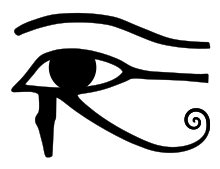Kemetism
Kemetism (also Kemeticism; both from the Egyptian kmt, usually voweled Kemet, the native name of ancient Egypt), also sometimes referred to as Neterism (from nṯr (Coptic ⲛⲟⲩⲧⲉ noute) "deity"), or Egyptian Neopaganism, is a revival of ancient Egyptian religion and related expressions of religion in classical and late antiquity, emerging during the 1970s. A Kemetic is one who follows Kemetism.[1]
| Part of a series on |
| Ancient Egyptian religion |
|---|
 |
|
Beliefs |
|
Practices
|
|
Deities (list) |
|
Locations |
|
Symbols and objects
|
|
Related religions
|
|
|
There are several main groups, each of which takes a different approach to their beliefs, ranging from eclectic to reconstructionist. However, all of these can be identified as belonging to three strains, including: reconstructed Kemetism (adopting a philological and scholarly approach), a syncretic approach, and a more novel synthesis tending toward monotheism, Kemetic Orthodoxy.[2]
Worship
Followers of Kemetism generally worship a few gods (Maat, Bast, Anubis, Sekhmet or Thoth, among others), but recognize the existence of every god. This worship generally takes the form of prayer and setting up altars, but there are no set guidelines for worship.[3] Altars can contain items such as candles, offerings, or statues.
Notes
- Daugherty, Michelle (2 October 2014). "Kemetism_Ancient Religions in our Modern World". Michigan State University. USA. Retrieved 18 January 2017.
- Harrison, PM (2012). Profane Egyptologists: The Revival and Reconstruction of Ancient Egyptian Religion. UCL (University College London).
- "Kemetic Starter Guide". The Twisted Rope. 2011-11-08. Retrieved 2018-12-12.
References
- Marilyn C. Krogh; Brooke Ashley Pillifant, Kemetic Orthodoxy: Ancient Egyptian Religion on the Internet: A Research Note, Sociology of Religion (2004).
- Ellen Cannon Reed, Circle of Isis: Ancient Egyptian Magic for Modern Witches (2002), ISBN 978-1-56414-568-0.
- J. G. Melton, Encyclopedia of American Religions, 5th ed., Detroit (1996).
External links
